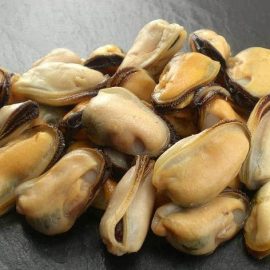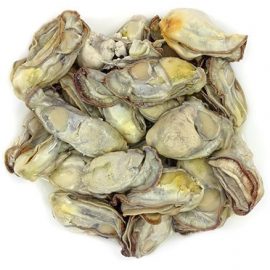Introduction
Oysters are a group of aquatic bivalve molluscs found in many parts of the world, often in shallow seas and near coastlines. Since ancient times, they have been a vital food source and part of human culture.
From Europe to North America, Asia, the Far East, and Africa, oysters are a type of seafood that has a long history of being consumed in diverse cultures. Their savoury and delicately sweet flavour has made them a highly sought-after culinary ingredient, used in various dishes, sauces, gratin, casseroles, and cocktails.
Description
Oysters are aquatic molluscs belonging to the Ostreidae family. They vary in size, shape, and colour, and are equipped with a muscular foot, an exterior expanded body wall, and a thick shell. Common species include the Eastern oyster (Crassostrea virginica), the Pacific oyster (Crassostrea gigas), and the European flat oyster (Ostrea edulis).
Oysters have been harvested and enjoyed since ancient times, with archaeological evidence suggesting their consumption as far back as Ancient Greece and Rome. Native Americans in North America were known to consume them before settlers, who began to widely harvest, eat, and trade Oysters in the 18th century. This was due to the increase in trade routes and better preservations techniques.
Physical Characteristics
An adult oyster is typically finger-sized to hand-sized in length and greyish-white to yellowish-brown in colour, with a glossy, iridescent inside.
Its body is usually covered in a two-part protective shell composed of calcium carbonate, ranging from round to oval. The outer valve of the oyster’s shell is typically solid and resistant to damage, and the inner valve is often characterised by concentric circles specific to the species.
Inside the mantle of the oyster are the body and heart of the oyster, including gills for gas exchange, a digestive tract, an anus for excretion, an eye and a series of nerve cells for sensory perception
The shape of the oyster is determined by the environment, with oysters in flowing waters having an elongated shape and those in still waters nested in a more circular shape.
Habitat
A wide range of habitats is suitable for native oysters, including shallow waters off coasts, shallow depths in brackish bays, and eutrophic and mesotrophic estuaries. Oysters usually grow in large colonies, providing a variety of habitats for other aquatic creatures.
In some areas, Oysters can live in far deeper waters. For example, the Pacific oysters can live in depths of up to 21 meters.
They are important keystone species that balance their ecosystems and provide food and habitat for many other species, including humans. In addition, oysters also help to disperse marine larvae throughout their habitats through their spawning activities.
Distribution of Stocks
Oysters are found in many coastal regions of Europe, North and South America, Asia, Australasia and Africa. They mostly prefer shallow coastal waters sheltered from strong currents and turbulences. However, oysters will also live in rivers, though they grow more slowly and have an increased risk from predators.
Oyster Fisheries
Oyster fisheries are a traditional practice that has been used since antiquity, providing human populations with essential nutrition and sustenance. Oysters are a type of mollusc found in the waters of salt and freshwater bodies, with oyster beds being common worldwide.
Comprehensive oyster fisheries ensure a plentiful supply for human consumption and provide vital marine ecosystems with the essential nutrients oysters offer, making these fisheries a critical part of a healthy, sustainable and balanced diet.
Conservation
Today, oysters remain an essential food source in many parts of the world. However, there have been many cases of overfishing and destruction of oyster populations due to environmental destruction.
To protect these populations, the oyster industry and governments have taken measures to ensure that the harvest is sustainable and that the vital habitat oysters provide for other marine life remains intact.
Sustainable Aquaculture and Oysters
Oysters are bivalve molluscs essential to many coastal and aquatic ecosystems. For this reason, the sustainable management of fresh oysters is an integral and necessary part of conservation efforts. To achieve this, best practices are intertwined with fisher management, aquaculture, and marine conservation.
Aquaculture is the practice of raising oysters in controlled environments with carefully managed resources. As part of these efforts, oysters are grown on a clutch bed or in tanks, mortality is controlled, harvesting is monitored, and regular monitoring and assessment are conducted to ensure that populations are healthy and balanced.
Additional methods to nurture and protect oyster populations include using synthetic reefs and the installation of artificial reefs to facilitate oyster settlement and growth. Oyster baggy systems, small sacks filled with seed oysters, can also be used to create a safe and sustainable environment for them. Furthermore, conserving nurseries and creating sanctuaries, which are not accessible for harvesting, are essential measures to protect oyster populations.
Local governments also manage wild oysters to ensure the health of their populations remains consistent and sustainable. Fisheries regulations, such as season limitations, bag limits, size and age limits, permit requirements, and other rules designed to prevent overharvesting, are also in place to ensure oysters are sustainably harvested.
Life Cycle of Oysters
Spawning is the primary means of oyster reproduction in late spring and early summer. During this process, a female oyster releases a large number of eggs into the surrounding water, which is then fertilised by sperm released from the male. These free-floating larvae, called spat, are carried by the current until they find a suitable substrate to attach themselves to. This is the juvenile stage of the oyster’s life cycle, which can take anywhere from six months to two years, depending upon species and environmental conditions.
Once the oyster reaches adulthood, it begins the protandrous hermaphroditic process, switching from male to female and releasing its larvae into the water. Oysters can spawn multiple times yearly, producing hundreds of millions of eggs. Given the right conditions, they can live for decades, occasionally lasting up to twenty years.
The Feeding Habits of Oysters
Wild Feeding Patterns
Oysters are bivalve molluscs that feed by filtering suspended particulates from the water column, using their gills to create water flow across their body. They primarily consume plankton, organic detritus, microalgae, other organic matter, and bacteria in their natural habitat. Oysters can adjust their feeding cycle to the increase and availability of plankton and regions with different food sources.
Specialised Feeding Mechanism
Oysters have a specialised feeding apparatus that helps them consume food particles as small as 0.2 microns. Primarily, they consume phytoplankton, diatoms, detritus, and dead or damaged animals. If encountered, they may also feed on marine snow and certain types of kelp.
Artificial Diets
In captive settings, such as aquaculture, oysters are fed formulated diets including fish offal, ground fishmeal or mussel meal. Pearl oysters, for example, can be fed grain-based feeds formulated from caster/soybean oil and other approved ingredients. Core feed components such as alfalfa meal, wheat bran, fish meal and sturgeon meal, additives and enhancers, such as vitamins, probiotics and essential amino acids, may be added to optimise their growth and reproductive function.
Significance
Overall, oysters are an important species. They serve as a habitat for other aquatic life and provide people with a nutritious food source. They are also harvested commercially and recreationally, helping reduce coastal nutrient and sediment inputs. In this way, oysters are essential for both humans and the environment.
Availability
Oysters are available in supermarkets and speciality stores in canned, frozen, pre-cooked, and complete forms. They are highly versatile and can be used in many recipes, including salads, sandwiches, appetisers, and entrees. As a result, they are found in Italian, French, and Asian cuisine, showing their widespread appeal.
Nutritional Values
Oysters are an excellent source of essential vitamins and minerals, including zinc, iron, Pantothenic acid, selenium, magnesium, manganese, phosphorus, niacin, Vitamin A, Vitamin B6, Vitamin C, Vitamin D, and Vitamin E. They are also rich in Omega-3 fatty acids, which are necessary for a healthy heart and brain functioning, and are a good source of B Vitamins, fibre, and antioxidants.
One average-sized oyster contains around 6.5 g of protein and 11 mg of calcium and is low in fat and calories at just 22 calories and 0.2 g of fat. It also contains a good amount of dietary fibre, with 1.5 g of dietary fibre and vitamins A, B-12 and D.
Benefits of Oysters
Oysters are essential to many cultures and cuisines due to their nutrition and flavour. Oysters are a good source of zinc and other minerals, offering many health benefits. They are also believed to have potential anti-inflammatory and antioxidant properties.
The health benefits of consuming oysters are significant. They include promoting a healthy heart and brain functioning, aiding digestion and supporting healthy cholesterol levels, and acting as a source of antioxidants to help protect the body from disease-causing free radical damage.
Flavor and Texture
Oysters have a sweet and mild taste compared to other types of fish, although some people may find the flavour slightly gamier than expected. An oyster’s texture is smooth and creamy – different from the textures of other types of fish.
Oysters have a calcium-rich flavour that pairs nicely with acidic wines like Sauvignon Blanc or Champagne and bolder seasonings and ingredients like lemon juice.
Cooking Oysters
The typical method of cooking oysters is different from that used with other types of fish. Generally, salmon and other fish can be cooked over a grill, while oysters should more typically be steamed or boiled. However, oysters can be cooked in various ways to make them flavorful and delicious.
Opening and Preparing an Oyster
Oysters are a type of bivalve mollusc prized for their flavour, texture, and versatility. There are many ways to serve oysters harvested from coastal waterways. Cooks can serve oysters raw, steamed, grilled, fried, or oven-roasted. Before preparing an oyster, however, it must be correctly and safely opened and prepped for the desired recipe. This process can become challenging for those unfamiliar with the best methods.
Opening and prepping an oyster is relatively simple and requires just a few steps. Begin by thoroughly scrubbing the oyster shells with a brush to remove barnacles and other debris. This also helps to ensure that the oyster is fresh and hygienic.
Once scrubbed, these edible oysters can be opened using an oyster knife. Slide the blade beneath the top shell and twist until the shell part. Cut through the invaginated mantle and adductor muscle connecting it to the shell, and then carefully pry away the adductor muscle, if desired, to facilitate plating. It is vital to use the proper tools, such as an oyster knife or protective glove, and to wear protective eyewear and clothing when handling live oysters.
Exploring Unique Combinations
Aside from traditional accompaniments, oysters can be paired with a wide array of side dishes to create a unique and delicious meal. Popular options include mashed potatoes, sweet-and-sour sauces, thick chutney, and Plantains. Simple sides like butter, lemon wedges, and salt can also bring out the oyster’s flavour.
Traditional Accompaniments for Oysters
An acidic fruit, such as lemon wedges or mignonette sauce, is a classic accompaniment to oysters that can balance out the salty taste. Rich sauces such as BBQ, garlic butter, tzatziki, tartar sauce, remoulade, tapenade, dijonnaise and aioli are also often included. Other traditional accompaniments include crunchy vegetables like celery, bell peppers, cucumbers, salads, crackers, and bread such as focaccia, French bread, and garlic toast.
Oysters can also be enjoyed on the half shell, with condiments such as Worcestershire sauce, cocktail sauce and Cajun seasoning. Beverages such as white wine, beer, cider, and sparkling wine can be enjoyed alongside oysters to enhance their flavour.
Popular Oyster Recipes
Oysters are a much-loved delicacy and can be used to create a vast array of recipes, incorporating classic and modern cooking techniques. For an exotic dinner, a special celebration, or something different, oysters can be the basis for both simple and extravagant dishes.
- Fried Oysters – Fried oysters are a classic dish found on menus all over the world. This simple preparation involves dredging the oysters in a light batter or flour and deep-frying them until golden brown. They can be enjoyed both warm or cold, with accompaniments such as tartar sauce or lemon wedges.
- Grilled Oysters – Grilling oysters is an easy way to add flavour to this sea-based treat. Pre-shucked oysters can be placed on a greased sheet or in an oyster basket, then placed over hot coals or the highest heat setting on a gas grill. Extra herbs or seasonings can also be added for more exciting results.
- Oyster Stew – Oyster stew is a traditional Southern dish. It is created by sautéing leeks and celery in butter, then adding heavy cream and bringing it to a simmer before adding the oysters. This dish is typically finished with sherry, Worcestershire sauce, and diced bacon.
- Barbecued Oysters – Barbecuing oysters brings out a smoky flavour and can be served plain or with accompaniments such as various sauces. Before barbecuing, the oysters should be oiled and the coals heated. The oysters should be placed flat side up and left until the oysters open up.
- Oyster Fritters – Oyster fritters are a classic that can be enjoyed as a snack, side dish, or appetiser. This recipe involves lightly seasoning oysters and coating them in a batter. The fritters can then be deep-fried in hot oil until golden brown.
- Oyster Shooter – Oyster shooters are a popular dish consisting of raw oysters served in a shot glass with accompaniments of Tabasco or a range of sauces. It can be enjoyed either alone or as part of an appetiser.
- Oyster Challis – A richly-flavoured dish, oyster challis is a variation on an oyster stew with a creamy sauce added for extra indulgence. The sauce is created by sautéing onions, garlic, and herbs in butter, adding oysters and white wine, followed by the cream. The stew is usually served with pasta but is also a delicious accompaniment for crackers or crusty bread.
- Oysters Rockefeller – Oysters Rockefeller is one of the more decadent oyster recipes and involves a rich sauce of cream, bacon, spinach, and anise. This delicacy can be enjoyed as an appetiser or as a larger meal.
Using oysters as an ingredient can bring a unique flavour to a wide range of dishes, and with a wealth of popular recipes to choose from, this seafood delicacy can make an impressive and tasty meal.
Cultural Significance
Oysters have been known to have been eaten since antiquity by the Ancient Romans, Egyptians and Chinese, as well as by numerous tribes throughout the world. They are eaten boiled, fried, in salads or fresh on the half shell.
Historically, oysters were considered a valuable and nutritious food source and have continued to be essential to many cultures worldwide.
Conclusion
Oysters have a long-standing place in seafood culture and the seafood industry due to their sustainability, growth, and hardiness. Their availability and culinary benefits have continued to make them a popular item in today’s market, resulting in significant benefits for both consumers and natural ecosystems.
Oysters have been providing humans with nutrition and environmental benefits for centuries. With increasing pressures on wild oyster populations, it is essential to maintain and preserve oyster resources to ensure their continued survival. This can be done by protecting natural habitats, reducing pollution and avoiding destructive fishing practices.



